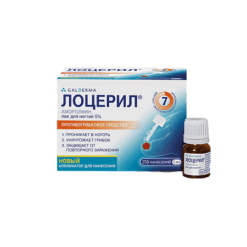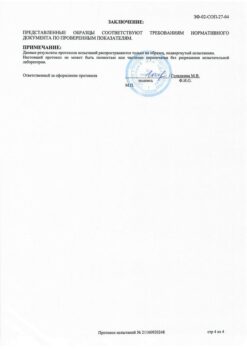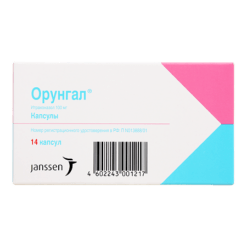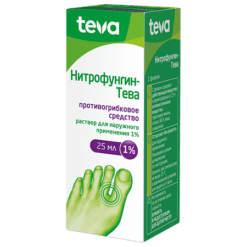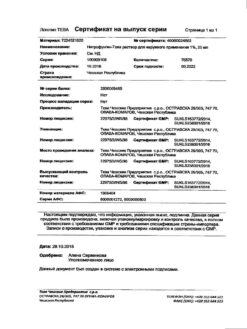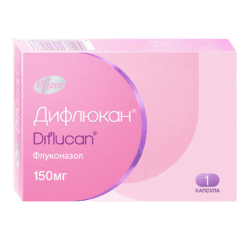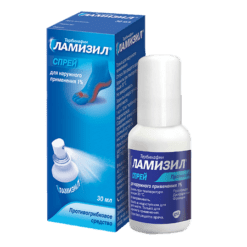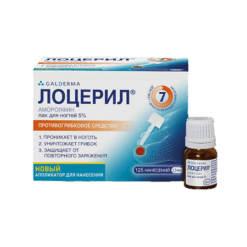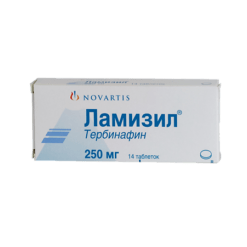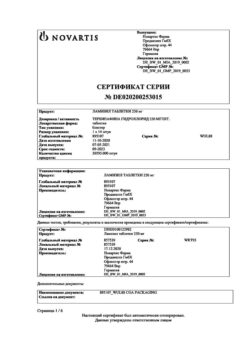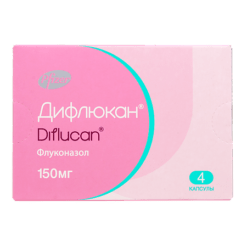No products in the cart.
Voriconazole Canon, 200 mg 14 pcs
€313.67 €261.39
Description
Voriconazole is a broad-spectrum antifungal drug from the triazole group. The mechanism of action of voriconazole is associated with the inhibition of demethylation of alpha-sterol mediated by fungal cytochrome P450 – a key step in ergosterol biosynthesis.
In vitro voriconazole has a broad spectrum of antifungal action: it is active against Candida spp. (including C. krusei, C. glabrata and C. albicans strains), Aspergillus sp., Scedosporium spp. The clinical efficacy of voriconazole has been demonstrated in infections caused by Aspergillus spp. including A. flavus, A. fumigatus, A. terreus, A. niger, A. nidulans), Candida spp. including C. albicans, C. glabrata, C. krusei, C. parapsilosis, C. tropicalis, and against a limited number of strains of C. dubliniensis, C. inconspicua, C. guillermondii, Scedosporium spp. including S. apiospermum, S. prolifecans and Fusarium spp. Other fungal infections for which voriconazole was used included isolated infections caused by Alternaria spp., Blastomyces dermatitidis, Blastoschizomyces capitatus, Cladosporium spp, Coccidoides immitis, Conidiobolus coronatus, Cryptococcus neoformans, Exserohilum rostratum, Exophiala spinifera, Fonsecaea pedrosoi, Madurella mycetomatis, Paecilomyces lilacinus, Penicillium spp. including P. marneffei, Philaphora richardsiae, Scopulariopsis brevicaulis and Trychosporon spp. including T. beigelii. In vitro activity of voriconazole was demonstrated against clinical strains of Acremonium spp., Alternaria spp., Bipolaris spp., Cladophialophora spp. and Listoplasma capsulatum. In vitro activity of voriconazole against Curvularia spp. and Sporothrix spp. was also detected, but the clinical significance of this effect is unknown.
Pharmacokinetics
General characteristics:Voriconazole pharmacokinetic parameters are characterized by significant interindividual variability. The pharmacokinetics of voriconazole is nonlinear due to its metabolic saturation. A disproportionate increase in the area under the “concentration-time curve” (AUCt) is observed when the dose is increased. Increasing the oral dose from 200 mg 2 times a day to 300 mg 2 times a day leads to an average 2.5-fold increase in AUСt. When administered orally, saturating doses of voriconazole, its plasma concentrations are close to equilibrium concentrations during the first 24 hours. If the drug is administered twice daily in medium doses, voriconazole is cumulated, and equilibrium concentrations are reached by the sixth day in most patients.
absorption and distribution:Voriconazole is rapidly and almost completely absorbed after oral administration; Cmaõ is reached 1-2 h after administration. Bioavailability of voriconazole when taken orally is 96%. When voriconazole is repeatedly taken with a fatty food, Cmaõ and AUСt are decreased by 34% and 24%, respectively. Absorption of voriconazole is independent of the pH of gastric juice. The average volume of distribution of voriconazole in equilibrium is 4.6 l/kg. Binding to plasma proteins is 58%. Voriconazole penetrates through the blood-brain barrier and is determined in the cerebrospinal fluid.
Metabolism: Voriconazole is metabolized by the isoenzymes CYP2C19, CYP2C9, CYP3A4. The CYP2C19 isoenzyme plays an important role in the metabolism of voriconazole, with a pronounced genetic polymorphism. In this regard, reduced voriconazole metabolism is possible in 15-20% of Asian people and 3-5% of Caucasian and Negroid people. It was found that voriconazole AUСt is on average 4 times higher in patients with decreased metabolism than in homozygous patients with high metabolism. Heterozygous patients with high metabolism have, on average, 2 times higher voriconazole AUCt than homozygous patients.
The main metabolite of voriconazole is N-oxide, which accounts for 72% of the total number of radioactively labeled metabolites circulating in plasma. This metabolite has minimal antifungal activity and does not contribute to the effect of voriconazole.
Elimation: voriconazole is excreted as metabolites; less than 2% of the administered dose of voriconazole is excreted unchanged by the kidneys. After repeated oral administration, about 83% of the voriconazole dose is detected in the urine. Most (> 94%) of the total dose is excreted within the first 96 h after oral administration. The T1/2 of voriconazole is dose-dependent and is approximately 6 h when administered orally at a dose of 200 mg. Because of nonlinearity of pharmacokinetics, the T1/2 value does not allow predicting cumulation or excretion of voriconazole.
Pharmacokinetics of special patient groups
Gender:When repeated oral administration of the drug, Cmaõ and AUCt were 83% and 113% higher, respectively, in healthy young women than in young healthy men. There were no significant differences in CmaX and AUCt in healthy elderly men and healthy elderly women (≥65 years). Equilibrium plasma concentration of voriconazole in women was 100% higher than in men after taking the drug in tablet form. There is no need to adjust the dose according to sex. Plasma concentrations in men and women are similar.
Age:when repeated oral voriconazole administration, Cmax and AUCt in healthy older men (≥65 years) are 61% and 86% higher, respectively, than in healthy young men (18-45 years). There were no significant differences in Cmax and AUСt in healthy older women (≥65 years) and healthy young women (18-45 years). There is no need to adjust the dose of voriconazole according to age.
Children:The same oral dose of voriconazole (200 mg 2 times daily, regardless of body weight) is required for children to achieve a concentration in children that is comparable to that of the maintenance dose of voriconazole for oral administration in adults 200 mg 2 times daily. No saturation dose is required, nor is the dose of voriconazole required to be adjusted according to age for children within the age range of 2 to 12 years. However, the bioavailability of the drug when taken orally in children may be limited by impaired absorption and fairly low body weight at this age.
Kidney function impairment:With a single oral dose of 200 mg of voriconazole in patients with normal renal function and in patients with renal impairment ranging from mild (creatinine clearance (CK) 41-60 ml/min) to severe (CK < 20 ml/min) the pharmacokinetics of voriconazole are not significantly affected by renal impairment. Binding of voriconazole to plasma proteins is approximately the same in patients with different degrees of renal impairment.
Hepatic dysfunction:After a single oral dose of 200 mg AUtvoriconazole in patients with mild to moderate cirrhosis (Child-Pugh grades A and B) was 233% higher than in patients with normal liver function. Impaired liver function does not affect the binding of voriconazole to plasma proteins. In repeated oral administration of this medicine AUСtvoriconazole was comparable in patients with medium degree of liver cirrhosis (class B according to Child-Pugh classification) who received this medicine in maintenance dose of 100 mg twice per day, and in patients with normal liver function who received voriconazole in dose 200 mg twice per day. There are no data about voriconazole pharmacokinetics in patients with severe cirrhosis of liver (class C according to Child-Pugh classification).
Indications
Indications
– invasive aspergillosis;
— severe invasive forms of candidiasis (including C. krusei);
– candidiasis of the esophagus;
– candidemia in patients without neutropenia;
— severe fungal infections caused by Scedosporium spp. and Fusarium spp;
– other severe invasive fungal infections with intolerance or refractoriness to other drugs;
— prevention of “breakthrough” fungal infections in patients with reduced immune system function, fever and neutropenia from a high-risk group (recipients of allogeneic bone marrow, patients with relapsed leukemia).
Pharmacological effect
Pharmacological effect
Voriconazole is a broad-spectrum antifungal drug from the triazole group. The mechanism of action of voriconazole is associated with inhibition of demethylation of 14 alpha-sterol mediated by fungal cytochrome P450, a key step in ergosterol biosynthesis.
In vitro, voriconazole has a broad spectrum of antifungal action: it is active against Candida spp. (including strains of C. krusei, C. glabrata and C. albicans), Aspergillus sp., Scedosporium spp., Fusarium spp. The clinical effectiveness of voriconazole has been demonstrated against infections caused by Aspergillus spp., including A. flavus, A. fumigatus, A. terreus, A. niger, A. nidulans), Candida spp., including C. albicans, C. glabrata, C. krusei, C. parapsilosis, C. tropicalis, as well as against a limited number of strains of C. dubliniensis, S. inconspicua, C. guillermondii, Scedosporium spp., including S. apiospermum, S. prolifecans and Fusarium spp. Other fungal infections for which voriconazole has been used include isolated cases of infections caused by Alternaria spp., Blastomyces dermatitidis, Blastoschizomyces capitatus, Cladosporium spp., Coccidoides immitis, Conidiobolus coronatus, Cryptococcus neoformans, Exserohilum rostratum, Exophiala spinifera, Fonsecaea pedrosoi, Madurella mycetomatis, Paecilomyces lilacinus, Penicillium spp., including P. marneffei, Philaphora richardsiae, Scopulariopsis brevicaulis and Trychosporon spp., including T. beigelii. Voriconazole activity has been demonstrated in vitro against clinical strains of Acremonium spp., Alternaria spp., Bipolaris spp., Cladophialophora spp., liistoplasma capsulatum. Voriconazole has also been shown to have in vitro activity against Curvularia spp. and Sporothrix spp., but the clinical significance of this effect is unknown.
Pharmacokinetics
General characteristics: the pharmacokinetic parameters of voriconazole are characterized by significant interindividual variability. The pharmacokinetics of voriconazole is nonlinear due to the saturation of its metabolism. As the dose increases, there is a disproportionate increase in the area under the concentration-time curve (AUCt). Increasing the oral dose from 200 mg 2 times a day to 300 mg 2 times a day leads to an average increase in AUCt of 2.5 times. When ingesting saturating doses of voriconazole, its concentrations in the blood plasma approach equilibrium during the first 24 hours. If the drug is prescribed 2 times a day in medium doses, voriconazole accumulates, and equilibrium concentrations are achieved by the sixth day in most patients.
Absorption and distribution: voriconazole is rapidly and almost completely absorbed after oral administration; Cmax is achieved 1-2 hours after administration. The bioavailability of voriconazole when taken orally is 96%. When voriconazole is repeated with a fatty meal, Cmax and AUCt are reduced by 34% and 24%, respectively. The absorption of voriconazole is independent of gastric pH. The mean volume of distribution of voriconazole at steady state is 4.6 L/kg. Plasma protein binding is 58%. Voriconazole penetrates the blood-brain barrier and is detected in the cerebrospinal fluid.
Metabolism: voriconazole is metabolized by the isoenzymes CYP2C19, CYP2C9, CYP3A4. An important role in the metabolism of voriconazole is played by the isoenzyme CYP2C19, which exhibits pronounced genetic polymorphism, and therefore, reduced metabolism of voriconazole is possible in 15-20% of representatives of Asian origin and in 3-5% of representatives of Caucasian and Negroid races. It was found that in patients with reduced metabolism, the AUCt of voriconazole is on average 4 times higher than in homozygous patients with high metabolism. In heterozygous patients with high metabolism, the AUCt of voriconazole is on average 2 times higher than in homozygous patients.
The main metabolite of voriconazole is N-oxide, which accounts for 72% of the total number of radiolabeled metabolites circulating in the blood plasma. This metabolite has minimal antifungal activity and does not contribute to the effect of voriconazole.
Elimination: voriconazole is excreted as metabolites; Less than 2% of the administered dose of voriconazole is excreted unchanged by the kidneys. After repeated oral administration, approximately 83% of the voriconazole dose is found in urine. The majority (>94%) of the total dose is eliminated within the first 96 hours after oral administration. T1/2 of voriconazole depends on the dose and is approximately 6 hours when taking the drug orally at a dose of 200 mg. Due to the nonlinearity of pharmacokinetics, the T1/2 value does not predict the accumulation or elimination of voriconazole.
Pharmacokinetics of special groups of patients
Gender: with repeated oral administration of the drug, Cmax and AUCt in healthy young women were 83% and 113%, respectively, higher than in young healthy men. There are no significant differences in Cmax and AUCt between healthy elderly men and healthy elderly women (≥ 65 years). The steady-state plasma concentration of voriconazole in women was 100% higher than in men after taking the drug in tablet form. There is no need for dose adjustment depending on gender. Plasma concentrations are similar in men and women.
Age: With repeated oral administration of voriconazole, Cmax and AUCt in healthy elderly men (≥ 65 years) were 61% and 86% higher, respectively, than in healthy young men (18-45 years). There are no significant differences in Cmax and AUCt in healthy elderly women (≥ 65 years old) and healthy young women (18-45 years old). There is no need to adjust the dose of voriconazole depending on age.
Children: To achieve voriconazole concentrations in children comparable to those administered with a maintenance dose of oral voriconazole for adults of 200 mg 2 times a day, the same dose of voriconazole for oral administration in children is required (200 mg 2 times a day, regardless of body weight). There is no need for a loading dose or age-related dose adjustment of voriconazole for children within the age range of 2 to 12 years. However, the bioavailability of the drug when taken orally in children may be limited by malabsorption and fairly low body weight at this age.
Impaired renal function: with a single oral dose of 200 mg voriconazole in patients with normal renal function and in patients with mild (creatinine clearance (CR) 41-60 ml/min) to severe (CR < 20 ml/min) renal impairment, the pharmacokinetics of voriconazole do not significantly depend on the degree of renal impairment. The binding of voriconazole to plasma proteins is approximately the same in patients with varying degrees of renal failure.
Liver dysfunction: After a single oral dose of 200 mg, the AUC of voriconazole in patients with mild to moderate liver cirrhosis (Child-Pugh classes A and B) was 233% higher than in patients with normal liver function. Impaired liver function does not affect the binding of voriconazole to plasma proteins. With repeated oral administration of the drug, the AUC of voriconazole is comparable in patients with moderate severity of liver cirrhosis (Child-Pugh class B) receiving the drug at a maintenance dose of 100 mg 2 times a day, and in patients with normal liver function receiving voriconazole at a dose of 200 mg 2 times a day. There is no information on the pharmacokinetics of voriconazole in patients with severe liver cirrhosis (Child-Pugh class C).
Special instructions
Special instructions
Use with caution in patients with severe liver failure, with severe renal failure (with parenteral administration), as well as with hypersensitivity to other drugs – azole derivatives.
Before starting treatment, correction of electrolyte disturbances (hypokalemia, hypomagnesemia and hypocalcemia) is required.
Sampling for cultural and other laboratory tests (serological, histopathological) for the purpose of isolating and identifying pathogens should be done before treatment. Therapy can be started before laboratory results are available and then adjusted if necessary.
The use of voriconazole may lead to prolongation of the QT interval on the ECG, which is accompanied by rare cases of ventricular fibrillation-flutter in patients with multiple risk factors (cardiotoxic chemotherapy, cardiomyopathy, hypokalemia and concomitant medications that could contribute to the development of adverse events from the cardiovascular system). Voriconazole should be used with caution in patients with these potentially proarrhythmic conditions.
During the treatment period, liver function should be regularly monitored (if clinical signs of liver disease appear, the advisability of discontinuing therapy should be discussed), renal function (including serum creatinine level).
If dermatological reactions progress, the drug should be discontinued.
During treatment, patients receiving voriconazole should avoid exposure to the sun and UV radiation.
With the simultaneous use of voriconazole in patients receiving cyclosporine and tacrolimus, the dose of the latter should be adjusted and their plasma concentrations should be monitored. After discontinuation of voriconazole, plasma concentrations of cyclosporine and tacrolimus should be assessed and their dose increased if necessary.
If concomitant use of voriconazole and phenytoin is necessary, the expected benefits and potential risks of combination therapy should be carefully assessed and phenytoin levels should be continuously monitored.
If it is necessary to use voriconazole and rifabutin together, the expected benefits and potential risks of combination therapy should be carefully assessed and carried out under the supervision of peripheral blood patterns, as well as other possible undesirable effects of rifabutin.
The safety and effectiveness of voriconazole in children under 2 years of age have not been established.
Impact on the ability to drive vehicles and operate machinery
Because voriconazole may cause transient visual disturbances, including blurred vision, impaired/increased visual perception and/or photophobia, patients should not engage in potentially hazardous activities such as driving or using complex machinery if such reactions occur. While using voriconazole, patients should not drive in the dark.
Active ingredient
Active ingredient
Voriconazole
Composition
Composition
Active ingredient:
voriconazole 200 mg;
Excipients:
pregelatinized corn starch 81 mg,
croscarmellose sodium 18 mg,
mannitol 83 mg,
magnesium stearate 3 mg,
microcrystalline cellulose 65 mg.
Film shell composition:
opadry II white 13 mg, including: polyvinyl alcohol 6.097 mg, macrogol 3.068 mg, talc 2.262 mg, titanium dioxide 1.573 mg.
Contraindications
Contraindications
– hypersensitivity to voriconazole or any other component of the drug.
– children under 3 years of age (for this dosage form).
– simultaneous use of the drug Voriconazole Canon and terfenadine, astemizole, cisapride, pimozide, quinidine, sirolimus, rifampicin, carbamazepine, long-acting barbiturates (phenobarbital), ergot alkaloids (ergotamine, dihydroergotamine), efavirenz (400 mg or more once a day), ritonavir (400 mg and above, 2 times a day), rifabutin, and St. John’s wort are contraindicated (see section “Interaction with other drugs”).
Side Effects
Side Effects
From the body as a whole: very often – fever, peripheral edema; often – chills, asthenia, chest pain, reactions and inflammation at the injection site, flu-like syndrome.
From the cardiovascular system: often – decreased blood pressure, thrombophlebitis, phlebitis; rarely – atrial arrhythmias, bradycardia, tachycardia, ventricular arrhythmias; very rarely – supraventricular tachycardia, complete AV block, bundle branch block, nodal arrhythmias, ventricular tachycardia (including ventricular flutter), prolongation of the QT interval, ventricular fibrillation.
From the digestive system: very often – nausea, vomiting, diarrhea, abdominal pain; often – increased activity of ALT, AST, alkaline phosphatase, LDH, GGT and bilirubin levels in the blood plasma, jaundice, cheilitis, cholestasis; rarely – cholecystitis, cholelithiasis, constipation, duodenitis, dyspepsia, liver enlargement, gingivitis, glossitis, hepatitis, liver failure, pancreatitis, swelling of the tongue, peritonitis; very rarely – pseudomembranous colitis, hepatic coma. In patients with serious underlying diseases (hematological malignancies), cases of severe hepatotoxicity (cases of jaundice, hepatitis, hepatocellular failure leading to death) have been reported rarely with the use of voriconazole.
From the endocrine system: rarely – adrenal insufficiency; very rarely – hyperthyroidism, hypothyroidism.
Allergic reactions: rarely – toxic epidermal necrolysis, Stevens-Johnson syndrome, urticaria; very rarely – angioedema, erythema multiforme. With intravenous infusion, anaphylactoid reactions have been described, including hot flashes, fever, sweating, tachycardia, chest tightness, shortness of breath, fainting, itching, rash.
From the hematopoietic system: often – thrombocytopenia, anemia (including macrocytic, microcytic, normocytic, megaloblastic, aplastic), leukopenia, pancytopenia; rarely – lymphadenopathy, agranulocytosis, eosinophilia, disseminated intravascular coagulation syndrome, suppression of bone marrow hematopoiesis; very rarely – lymphangitis.
Metabolism: often – hypokalemia, hypoglycemia; rarely – hypocholesterolemia.
From the musculoskeletal system: often – back pain; rarely – arthritis.
From the central nervous system and peripheral nervous system: very often – headache; often – dizziness, hallucinations, confusion, depression, anxiety, tremor, agitation, paresthesia; rarely – ataxia, cerebral edema, intracranial hypertension, hyposthesia, nystagmus, dizziness, fainting; very rarely – Guillain-Barré syndrome, oculomotor crisis, extrapyramidal syndrome.
From the respiratory system: often – respiratory distress syndrome, pulmonary edema, sinusitis.
Dermatological reactions: very often – rash; often – itching, maculopapular rash, photosensitivity, alopecia, exfoliative dermatitis, facial edema, purpura; rarely – psoriasis; very rarely – discoid lupus erythematosus.
From the senses: often – visual disturbances (including impaired/increased visual perception, fog before the eyes, changes in color perception, photophobia); rarely – blepharitis, optic neuritis, papilledema, scleritis, impaired taste perception, diplopia; very rarely – retinal hemorrhage, corneal opacification, optic nerve atrophy.
From the urinary system: often – increased creatinine levels in the blood serum, acute renal failure, hematuria; rarely – increased residual urea nitrogen, albuminuria, nephritis; very rarely – necrosis of the renal tubules.
Interaction
Interaction
Voriconazole is metabolized with the participation of isoenzymes CYP2C19, CYP2C9 and CYP3A4. Inhibitors or inducers of these isoenzymes may cause an increase or decrease in voriconazole plasma concentrations, respectively.
When used simultaneously with rifampicin (an inducer of CYP isoenzymes) at a dose of 600 mg/day, the Cmax and AUC of voriconazole are reduced by 93% and 96%, respectively (the combination is contraindicated).
When coadministered with voriconazole, ritonavir (a CYP isoenzyme inducer, CYP3A4 inhibitor and substrate) at a dose of 400 mg every 12 hours reduced the steady-state Cmax and AUC of oral voriconazole by an average of 66% and 82%, respectively. The effect of lower doses of ritonavir on voriconazole concentrations is not yet known. It has been established that repeated oral use of voriconazole does not have a significant effect on Cmax at steady state and AUC of ritonavir, also taken repeatedly (simultaneous use of voriconazole and ritonavir at a dose of 400 mg every 12 hours is contraindicated).
When used concomitantly with potent CYP isoenzyme inducers carbamazepine or long-acting barbiturates (phenobarbital), a significant decrease in the plasma Cmax of voriconazole is possible, although their interaction has not been studied. This combination is contraindicated.
When used together with cimetidine (a nonspecific inhibitor of CYP isoenzymes) at a dose of 400 mg 2 times / day, the Cmax and AUC of voriconazole increase by 18% and 23%, respectively (no dose adjustment of voriconazole is required).
Voriconazole inhibits the activity of CYP2C19, CYP2C9, CYP3A4, so it is possible to increase plasma concentrations of drugs that are metabolized by these isoenzymes.
With the simultaneous use of voriconazole with terfenadine, astemizole, cisapride, pimozide and quinidine, a significant increase in their plasma concentrations is possible, which can lead to prolongation of the QT interval and in rare cases to the development of ventricular fibrillation/flutter (the combination is contraindicated).
When used together, voriconazole increases the Cmax and AUC of sirolimus (2 mg once) by 556% and 1014%, respectively (the combination is contraindicated).
When used concomitantly, voriconazole may cause an increase in plasma concentrations of ergot alkaloids (ergotamine and dihydroergotamine) and the development of ergotism (this combination is contraindicated).
When used together in stable renal transplant patients, voriconazole increases the Cmax and AUC of cyclosporine by at least 13% and 70%, respectively, which is accompanied by an increased risk of nephrotoxic reactions. When using voriconazole in patients receiving cyclosporine, it is recommended to reduce the dose of cyclosporine by 2 times and monitor its plasma levels. After discontinuation of voriconazole, cyclosporine levels should be monitored and the dose increased if necessary.
When used together, voriconazole increases the Cmax and AUC of tacrolimus (used at a dose of 0.1 mg/kg once) by 117% and 221%, respectively, which may be accompanied by nephrotoxic reactions. When using voriconazole in patients receiving tacrolimus, it is recommended to reduce the dose of the latter to 1/3 and monitor its plasma levels. After discontinuation of voriconazole, it is necessary to monitor the concentration of tacrolimus and, if necessary, increase its dose.
The simultaneous use of voriconazole (at a dose of 300 mg 2 times / day) and warfarin (30 mg 1 time / day) was accompanied by an increase in the maximum prothrombin time to 93%. When prescribing warfarin and voriconazole simultaneously, it is recommended to monitor prothrombin time.
Voriconazole, when used together, may cause an increase in plasma concentrations of phenprocoumon, acenocoumarol (CYP2C9, CYP3A4 substrates) and prothrombin time. When using voriconazole in patients receiving coumarin drugs, it is necessary to monitor prothrombin time at short intervals and adjust the dose of anticoagulants accordingly.
When used together, voriconazole may cause an increase in plasma concentrations of sulfonylurea derivatives (CYP2C9 substrates) tolbutamide, glipizide and glibenclamide and cause hypoglycemia. If they are used concomitantly, carefully monitor blood glucose levels.
In vitro, voriconazole inhibits the metabolism of lovastatin (a CYP3A4 substrate). When used together, it is possible to increase the plasma concentration of statins metabolized by CYP3A4, which may increase the risk of developing rhabdomyolysis. When using them simultaneously, it is recommended to evaluate the feasibility of adjusting the statin dose.
In vitro, voriconazole inhibits the metabolism of midazolam (a CYP3A4 substrate). When used together, it is possible to increase the plasma concentration of benzodiazepines metabolized under the influence of CYP3A4 (midazolam, triazolam, alprazolam) and the development of a prolonged sedative effect. If these drugs are used concomitantly, it is recommended to discuss the advisability of adjusting the benzodiazepine dose.
When used together, voriconazole may increase the content of vinca alkaloids (CYP3A4 substrates) – vincristine, vinblastine in plasma and lead to the development of neurotoxic reactions. It is recommended to discuss the advisability of dose adjustment of vinca alkaloids.
Voriconazole increases the Cmax and AUC of prednisolone (CYP3A4 substrate) administered at a dose of 60 mg once by 11% and 34%, respectively. Dose adjustment is not recommended.
When used concomitantly with voriconazole, efavirenz (a CYP3A4 substrate, according to a number of studies, depending on the dose – an inhibitor or inducer of CYP3A4), used at a dose of 400 mg 1 time / day at steady state, reduces the Cmax and AUC of voriconazole by an average of 61% and 77%, respectively. Voriconazole at steady state (400 mg PO every 12 hours on day 1, then 200 mg PO every 12 hours for 8 days) increased the steady-state Cmax and AUC of efavirenz by an average of 38% and 44%, respectively (this combination is contraindicated).
When used together, phenytoin (a CYP2C9 substrate and a powerful inducer of cytochrome P450 isoenzymes), used at a dose of 300 mg 1 time / day, reduces the Cmax and AUC of voriconazole by 49% and 69%, respectively; and voriconazole (400 mg 2 times / day) increases the Cmax and AUC of phenytoin by 67% and 81%, respectively (if coadministration is necessary, the ratio of the expected benefits and potential risks of combination therapy should be carefully assessed, and phenytoin plasma levels should be carefully monitored).
When used together, rifabutin (a cytochrome P450 inducer) used at a dose of 300 mg 1 time / day reduces the Cmax and AUC of voriconazole (200 mg 1 time / day) by 69% and 78%, respectively. When used together with rifabutin, the Cmax and AUC of voriconazole (350 mg 2 times/day) are, respectively, 96% and 68% of those with voriconazole monotherapy (200 mg 2 times/day). When using voriconazole at a dose of 400 mg 2 times / day, Cmax and AUC are, respectively, 104% and 87% higher than when using voriconazole monotherapy at a dose of 200 mg 2 times / day. Voriconazole at a dose of 400 mg 2 times / day increases the Cmax and AUC of rifabutin by 195% and 331%, respectively. During simultaneous treatment with rifabutin and voriconazole, it is recommended to regularly conduct a detailed analysis of the peripheral blood picture and monitor for undesirable effects of rifabutin (for example, uveitis).
When used together at a dose of 40 mg 1 time / day, omeprazole (inhibitor of CYP2C19; substrate of CYP2C19 and CYP3A4) increases the Cmax and AUC of voriconazole by 15% and 41%, respectively, and voriconazole increases the Cmax and AUC of omeprazole by 116% and 280%, respectively (hence, no dose adjustment of voriconazole is required, and the dose omeprazole should be reduced by 2 times). The possibility of drug interaction between voriconazole and other H+-K+-ATPase inhibitors that are substrates of CYP2C19 should be taken into account.
When used concomitantly with other HIV protease inhibitors (substrates and inhibitors of CYP3A4), the patient’s condition should be carefully monitored for possible toxic effects, because In vitro studies have shown that voriconazole and HIV protease inhibitors (saquinavir, amprenavir, nelfinavir) may mutually inhibit each other’s metabolism.
Manufacturer
Manufacturer
Kanonpharma production CJSC, Russia
Additional information
| Manufacturer | Kanonfarma Production ZAO, Russia |
|---|---|
| Medication form | pills |
| Brand | Kanonfarma Production ZAO |
Related products
Buy Voriconazole Canon, 200 mg 14 pcs with delivery to USA, UK, Europe and over 120 other countries.


